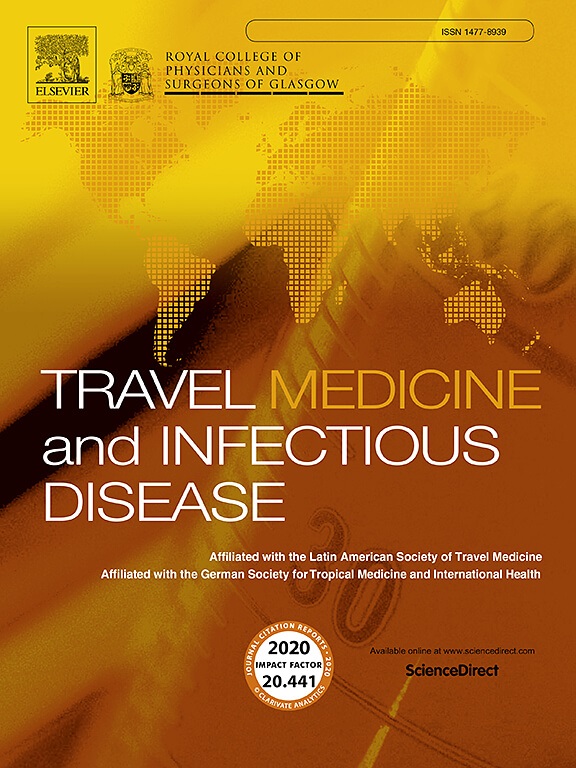厄瓜多尔一棵空心树暴露于鸟粪后爆发急性肺组织胞浆菌病
IF 4.7
3区 医学
Q1 INFECTIOUS DISEASES
引用次数: 0
摘要
背景:在经典流行地区之外,由于旅行过程中行为的改变,免疫能力强的旅行者的发病率增加,组织浆菌病引起了人们的关注。方法对5例前往厄瓜多尔亚马逊地区旅行后出现急性肺组织胞浆菌病的患者进行分析。结果5例患者(4女1男)均为20多岁,在前往厄瓜多尔亚马逊地区旅行后可能经空气接触后16至23天内出现急性肺组织胞浆菌病。据推测,最初的常见接触是在中空树干内活动时发生的鸟粪接触。最初症状包括3例发热和关节肌痛,另外2例胃肠症状伴虚弱和淋巴结肿大。症状在一周内有不同程度的进展,包括胸痛、呼吸困难和盗汗。2例患者急性期血清学阴性,但随后全部转为阳性。所有病例均在症状出现后一周内进行胸部CT扫描,发现双侧多发结节。在3例患者中,症状出现4 - 6周后随访胸部CT扫描显示,尽管给予伊曲康唑治疗,结节仍演变为空洞。结论这组组织胞浆菌病病例突出了与真菌感染相关的临床变异性。在疾病急性期肺空化的发展是一种罕见的发现,这带来了额外的临床挑战,并建议对从亚马逊地区返回的急性组织浆菌病患者进行严格的随访。本文章由计算机程序翻译,如有差异,请以英文原文为准。
An outbreak of acute pulmonary histoplasmosis after exposure to guano in a hollow tree in Ecuador
Background
Outside of classic endemic areas, histoplasmosis has gained attention due to an increased incidence in immunocompetent travellers, attributable to changes in behaviours during travel.
Methods
A cluster of five patients who presented with acute pulmonary histoplasmosis after travelling to the Ecuadorian Amazon Region is described in this article.
Results
Five patients (four females and one male), all in their 20s, presented with acute pulmonary histoplasmosis between sixteen and twenty-three days after the potential airborne exposure after travelling to the Ecuadorian Amazon Region. The initial common exposure is presumed to have occurred during activities inside a hollow tree trunk with guano exposure. Initial symptoms included fever and arthro-myalgias in three cases, and gastrointestinal symptoms with asthenia and lymphadenopathy in the other two cases. Symptoms progressed variably within one week to include chest pain, dyspnoea, and night sweats. Serology was negative in 2 patients during the acute phase but subsequently turned positive in all five cases. Chest CT scans performed within one week from symptom onset in all cases revealed multiple bilateral nodules. In three cases, follow-up chest CT scans performed four-six weeks after symptom onset showed the evolution of nodules into cavitations despite treatment with itraconazole.
Conclusions
This cluster of histoplasmosis cases highlights the clinical variability associated with this fungal infection. The development of pulmonary cavitation during the acute phase of the disease is an infrequent finding that poses additional clinical challenges and suggests the requirement of rigorous follow-up in individuals with acute histoplasmosis returning from the Amazon region.
求助全文
通过发布文献求助,成功后即可免费获取论文全文。
去求助
来源期刊

Travel Medicine and Infectious Disease
PUBLIC, ENVIRONMENTAL & OCCUPATIONAL HEALTH-INFECTIOUS DISEASES
CiteScore
19.40
自引率
1.70%
发文量
211
审稿时长
49 days
期刊介绍:
Travel Medicine and Infectious Disease
Publication Scope:
Publishes original papers, reviews, and consensus papers
Primary theme: infectious disease in the context of travel medicine
Focus Areas:
Epidemiology and surveillance of travel-related illness
Prevention and treatment of travel-associated infections
Malaria prevention and treatment
Travellers' diarrhoea
Infections associated with mass gatherings
Migration-related infections
Vaccines and vaccine-preventable disease
Global policy/regulations for disease prevention and control
Practical clinical issues for travel and tropical medicine practitioners
Coverage:
Addresses areas of controversy and debate in travel medicine
Aims to inform guidelines and policy pertinent to travel medicine and the prevention of infectious disease
Publication Features:
Offers a fast peer-review process
Provides early online publication of accepted manuscripts
Aims to publish cutting-edge papers
 求助内容:
求助内容: 应助结果提醒方式:
应助结果提醒方式:


